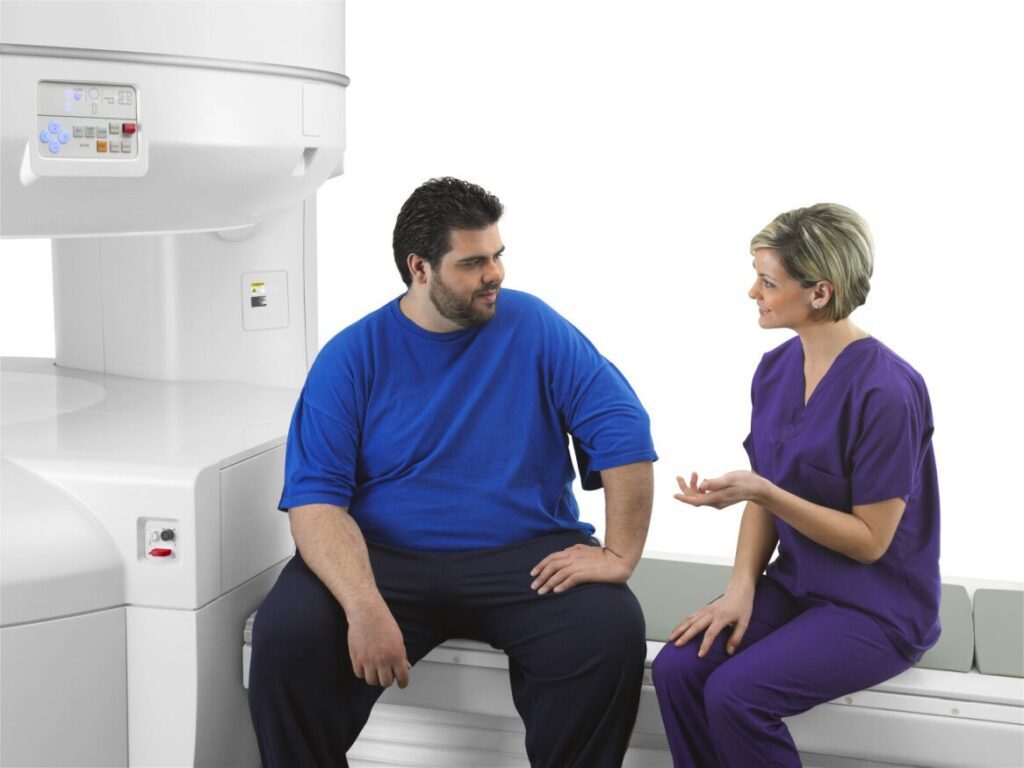Your healthcare provider has just recommended you have an MRI scan. Not only does this make you anxious, but to add to the stress, you also suffer from claustrophobia.
You’re not alone. More than 12% of the U.S. population suffer from some form of claustrophobia, the majority being women.
Today, however, you can put that particular worry behind you because of something called an open MRI.
Introduction to open MRI
An open MRI is just what it sounds like: there’s more room and more space in an open MRI machine than in a traditional closed MRI machine. But first, what is an MRI scan?
Magnetic resonance imaging, or MRI, is a noninvasive imaging scan that produces detailed images of almost every internal structure in the human body, including organs, bones, muscles, and blood vessels.
MRI scanners create images of the body using large magnets and radio waves.
What is an open MRI? How is it different from a traditional closed MRI?
An open MRI machine has much more space than a traditional closed MRI machine due to the placement of the magnets.
There are two types of open MRI machines.
The first type is an open MRI machine open on all sides, except above and below you where the magnets are located. The table slides under the top for you to be scanned.
The second type has the magnets located on the sides. The machine is open above you, behind you, and in front of you. You can stand, sit, or lay down depending upon the type of scan.
For many people, an open MRI is more comfortable and easier to tolerate than traditional closed MRI machines.
Why did my healthcare provider recommend an open MRI?
Your healthcare provider knows an open MRI scan offers you relief from claustrophobia, while also providing the quality imaging they need to guide your care.
During an open MRI, you will likely feel less cramped and confined,and most importantly, less stressed and anxious.
Why do some patients prefer an open MRI?
Studies have shown that people who suffer from claustrophobia are not necessarily frightened of enclosed spaces, but of what could happen in the enclosed space.
MRI technology is used to help identify patients’ health issues and, many times, to help save their lives. It is important, but a closed MRI could be a barrier to getting important medical care.
In short, many people prefer an open MRI because of its less confined space and will choose to get care sooner as they do not have to use a closed MRI.
Getting ready for your open MRI appointment
Your open MRI appointment has been scheduled and you’ve done your homework. Now it’s time to get ready for your open MRI scan. Here are some helpful tips to get prepared.

What do I need to do to prepare for my open MRI?
Most importantly, before your appointment, inform your healthcare provider of any concerns or issues you may have.
Also tell them if you have any metal or electronic objects in your body, like a metallic joint replacement or a pacemaker, as these may interfere with the magnets in the open MRI machine. Avoid wearing any jewelry or metal on your body.
Before the appointment, avoid excess alcohol and caffeinated beverages.
Wear comfortable clothes and be prepared to change into a hospital gown at the imaging center.
If you think you might still have a claustrophobic episode, bring an eye mask with you and focus on your breathing and other stress-relief exercises. It’s also an excellent idea to bring someone you trust with you.
If you feel that you need medication to help you through your scan, speak with your healthcare provider before your appointment.
Are there any restrictions on eating or drinking before the scan?
Talk to your healthcare provider about any eating or drinking restrictions before the scan.
Usually, you can eat, drink, and take your medications before your open MRI scan. However, in certain cases, your healthcare provider may instruct you to refrain from consuming food or drink for four hours before the scan.
What items of clothing or accessories should I avoid wearing?
It’s a good idea to wear comfortable, loose clothing to your open MRI appointment.
In addition to lessening your stress level, this will make it easier to change into a hospital gown for the scan.
Remove any jewelry or metal objects as these may interfere with the magnets of the open MRI machine.
During your open MRI scan
An open MRI scan is nothing to worry about. It’s a non-invasive scan, and although you may be somewhat uncomfortable during the scan, there will be no pain. Let’s find out more about an open MRI scan and what it entails.
How long does an open MRI usually take?
An open MRI scan usually requires 30 minutes to an hour to perform. The actual duration will depend on the body parts under assessment and the complexity of the scan.
How will I be positioned inside the open MRI machine?
It will depend on the type of open MRI machine and the body part being scanned.
In open MRI machines with the magnets above and below the table, you will lie on the table and will go under the magnet. For example, if your knee is being scanned, then the bottom half of your body will be under the magnet with your head out. The machine is open on all sides and there is room between your body and the top magnet.
In open MRI machines with the magnets on the sides, you will either lie flat, sit, or stand for your scan. For example, if you have back pain while standing, you will stand for your exam. The machine is open in front of, behind, and above you.
What should I do if you feel uncomfortable or anxious during the scan?
Before the scan, make sure to let your technologist know of any concerns you may have, such as claustrophobia. They will make sure to do everything they can to lessen your stress.
Also, you will be in communication with the technologist throughout the scan, so if you feel uncomfortable or anxious, feel free to speak up.
After your open MRI
Your open MRI scan is over now and you’ll probably wonder why you were anxious at all. Let’s discuss what comes next.
What does aftercare look like following an open MRI?
A radiologist, who is trained in MRI imaging, will examine your results and forward them to your healthcare provider. Your healthcare provider will then discuss those results with you.
How long does it typically take to get results from an open MRI scan?
Usually, your healthcare provider will have the results from your open MRI scan within a few days.
Who will discuss my MRI results with me? What questions should I ask?
Your healthcare provider will discuss your MRI results with you. Be proactive and prepared.
Some of the language and terms of the results can be very technical, so make sure you ask your healthcare provider to clarify in simple terms during this discussion if needed.
Also, you’re welcome to ask any questions you may have, no matter how trivial you may think they may be.
Your health is important, so be involved. Here are some good questions to ask:
- “Tell me more about what the MRI scan showed.”
- “What do these results mean for me, short-term and long-term?
- “What potential treatment options are available for me and what do they entail?”
- “Will you be referring me to a specialist? How does that work?”
How to schedule an MRI appointment with us
Reach out to us at American Health Imaging, and we’ll help you schedule an appointment at an imaging center near you, today.
We’re here to help you get the answers you need.
Frequently asked questions
What is an open MRI, and how does it differ from a traditional MRI?
An open MRI differs from traditional closed MRI machines by being open either in front of, behind, and above you or open on all sides.
Why would my healthcare provider recommend an open MRI?
Your healthcare provider may recommend an open MRI if you have claustrophobia, require more space, or need more comfort during the scan.
Why do some patients prefer an open MRI?
Patients often prefer an open MRI because it is less confining and reduces feelings of claustrophobia, making the experience more comfortable for some people.
How should I prepare for my open MRI appointment?
Wear loose clothing without metal fasteners, avoid wearing anything made of metal, and follow any specific instructions your healthcare provider gives you.
Are there any eating or drinking restrictions before an open MRI?
Generally, you can eat and drink normally unless otherwise instructed by your healthcare provider, though specific scans may have different requirements.
What clothing or accessories should I avoid wearing for an open MRI?
Avoid wearing jewelry, belts, watches, and clothing with metal zippers or snaps, as these can interfere with the MRI imaging.
How long does an open MRI scan usually take?
An open MRI scan typically takes between 30 to 60 minutes depending on the part of the body being examined.
What should I do if I feel uncomfortable or anxious during the open MRI?
If you feel uncomfortable or anxious during the scan, use the buzzer or intercom to alert the technologist, who can assist and provide support.
